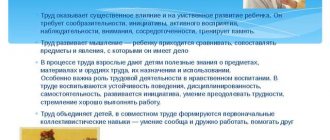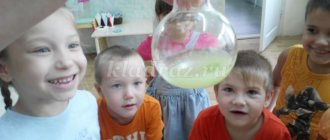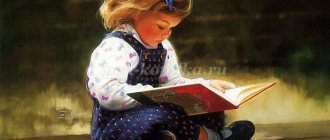Development of constructive activity in preschool age
The work of children in kindergarten is varied. This helps maintain their interest in activities and realize their comprehensive perception. One of the main types is construction and manual labor. A child’s manual labor is one of the components of his aesthetic activity; it develops children’s constructive abilities, creativity, imagination, and invention. Decorative and applied art is a child’s creative work with various materials, during which he creates useful and aesthetically significant objects and products for home decoration (games, labor, gifts for mother, leisure). By working with paper and cardboard products, the child acquires additional knowledge and practical skills, while simultaneously expanding his horizons. He develops a figurative idea of the possibilities of objects, he learns to build and create, and find unexpected uses for them. He also develops his creative imagination, which is important for any activity, both in kindergarten and at school. The fundamental point in design is the analytical and synthetic activity of studying objects. This allows you to determine the structure of the object and its parts and consider the logic of their connection. Based on analytical and synthetic activity, the child plans the progress of construction and creates a plan. The success of the implementation of a plan is largely determined by the preschooler’s ability to plan and control the progress of work.
Formation is the first, main type of activity necessary for a child in the early stages of development of visual activity. By touching objects, children develop ways of exploring objects and recognizing their shapes.
When sculpting, a child learns the three-dimensional shape of an object, the relationship of its parts, he develops skills in working with both hands, coordination of movements, small muscles of the fingers are very actively developing, and this contributes to the development of thinking, vision, and spatial thinking. It is difficult to overestimate the importance of modeling in a child's development. Modeling is the most dynamic, joyful children's art. Even small children are attracted to the opportunity to shape “real” nuts and feed them to the squirrel. Any manipulations with shaped objects and their use in play situations significantly enrich the child’s life experience. The more often a child engages in modeling, the more general and visual skills he develops. The child sets serious goals and develops constructive thinking. After all, it’s not enough to portray a person, he must also be able to stand on his feet.
Color, like shape and movement, is a means of expression in modeling. None of the children would think of sculpting Baba Yaga from pink plasticine; they always sculpt the trees in the garden of Koshchei the Immortal from dark-colored plasticine. To model dolls, they choose colors that are pleasing to the eye and find expressive details (a bright bow, decorative elements). Color is the most powerful means of expression, even in modeling. If you give a child the choice of sculpting with regular or colored clay, he will always prefer colored clay.
The application allows the child to see the outline of an object, which then becomes the basis for a graphic image that serves as a support for the development of the child's visual skills, that is, the ability to imagine an object of a certain shape. During the implementation of collages, conditions are also created for the formation of purposeful activity and the development of general intellectual abilities. In drawing, sculpting, appliqué and design lessons, children develop their language: they learn the names of colors and their shades, spatial characteristics and enrich their vocabulary. Young children are taught to paste ready-made geometric shapes and pictures onto paper. They are shown how to apply glue to them and place them on paper. The teacher involves the children in explaining the tasks and the order of their completion. During the analysis of the work, at the end of the lesson, children talk about their drawings, modeling, and express their opinions about the work of other children.
Through systematic construction and use, children intensively develop their sensory and mental abilities. Forming ideas about objects requires mastering knowledge about their properties and qualities, shape, color, size, position in space.
Children become familiar with the techniques of folding, creasing, cutting, and gluing paper. These complex concepts are easily acquired by children when creating a decorative pattern or depicting an object in parts. When learning to be productive, children learn to use materials carefully, keep them clean and tidy, and use only necessary materials in a certain order. All these points contribute to successful learning activities in all lessons.
Productive activity as a means of patriotic education of older preschoolers
Productive activity as a means of patriotic education of older preschoolers
Performed:
Krivorotova M. I.
Teacher of MBDOU No. 183,
Raising children's love for their fatherland is a pressing problem at the present stage.
The problem of patriotic education is becoming acutely relevant, but at the same time becoming extremely complex. These difficulties are caused by a rethinking of the very concept of patriotism in society. Patriotism is a worldview defined by love for the Motherland, native land, devotion to one’s fatherland, and the desire to achieve a better future for it.
Objective of the project:
show the effectiveness of patriotic education through productive activities
Object of study:
patriotic education of older preschoolers.
Subject of research:
the process of using productive activities in the patriotic education of preschool children.
Research hypothesis:
Productive activity is a means of patriotic education of older preschoolers
Research objectives:
-To determine the pedagogical foundations of the problem of forming patriotic feelings in children of senior preschool age.
-Summarize and expand students’ knowledge about the symbols of the state during the Second World War, orders, medals of the heroes of the Second World War. -Develop creative abilities within the framework of the project. -Expand your vocabulary of words denoting the names of objects, actions, signs. -Consolidate the acquired knowledge in productive activities by completing both collective and individual work. -Continue to cooperate with parents. -To foster respect among students for their country. -Develop a methodological collection of notes and activities for older children on the topic. Research base:
MBDOU No. 183, city. Samara, senior children
Research methods:
theoretical -
study and analysis of psychological, pedagogical and specialized literature;
design; empirical
(observation; study of work experience; analysis; generalization; pedagogical experiment);
Having analyzed the sources of literature on the problem of patriotic education of children of senior preschool age through productive activities in the theoretical part of my research, I came to the following conclusions:
1. By patriotic education of children of senior preschool age we understand the interaction of an adult and children in joint activities and communication, which is aimed at revealing and developing positive moral qualities of the individual in the child, familiarizing him with the origins of national regional culture, the nature of his native land, love and respect for small The Motherland, its history, native language, its people, its customs and ideals.
2. The pliability, known suggestibility of older preschoolers, their gullibility, tendency to imitate and the enormous authority enjoyed by teachers create favorable preconditions for the successful patriotic education of children. Children of older preschool age are characterized by emotionality. Feelings dominate all aspects of his life, determine actions, act as motives for behavior, and express the child’s attitude towards the environment. These features make it possible to instill in children a love for their native land. At the same time, this process must be carried out based on the child’s cognitive environment, his imagination and memory. Educational material should be understandable to children and arouse their interest.
It was found that there is no single approach to the definition of “patriotic education”.
Patriotic education of children is one of the main tasks of a preschool educational institution.
I found out that these problems are solved in all types of children's activities: in classes, in games, in work, in everyday life.
The task of the preschool educational institution is to involve parents in the pedagogical process, to expand the scope of parental participation in organizing the life of a preschooler in the preschool educational institution, creating conditions for the creative self-realization of not only teachers, children, but also parents.
I was convinced that all the studied means and methods, when used correctly and comprehensively, can contribute to the formation of highly moral feelings, thoughts, ideals, beliefs, i.e., the formation of everything that over time becomes the worldview of the individual of the country’s younger generation.
It follows from this that the basis of patriotic education is the moral, aesthetic, labor, and mental education of a little person. In the process of such versatile education, the foundation is born on which a more complex education will grow - a feeling of love for one’s Fatherland.
According to the purpose of my research and the tasks set in this chapter, it is necessary to experimentally test the influence of productive activity on the patriotic education of older preschoolers.
The experimental work was carried out on the basis of MBDOU kindergarten No. 183. Samara. 25 children from the senior “Butterfly” group took part in the study.
Test questions were selected for students in the senior group, which were divided into 3 blocks.
Thus, during the diagnostic process, the following results were obtained: Children demonstrated a low level of patriotism - 67%, which indicates the problem of developing a patriotic feeling through familiarizing pupils with the symbols of the state during the Second World War, orders, medals of the heroes of the Second World War, with the heroes of the Second World War and with the history of the Second World War according to the age of the children.
In my work, I use a variety of forms and methods of patriotic education: targeted walks, excursions, visiting museums, observations, conversations, modeling, games, using works of art, looking at albums, photographs, getting to know folk art.
Direct educational activities
- “Nobody knows, but everyone remembers”
- — “Orders and medals of the Second World War”
- — “Symbols of the Second World War”
- — “Children are heroes of the Second World War”
- — “Dedicated to the city heroes”
- - "My street"
- - “Let there never be war!”
- - “We will never forget their great feat!” -meeting with a WWII veteran
- — “Victory Spring”
- - “Thank you for the world!”
- — “Music salon “Songs of the War Years”
Observation - looking
- "Soviet artists about the war"
- “Photograph of days gone by” (presentation - a selection of slides about the war for children)
- “Children-heroes of war” (presentation - a selection of slides about children of war)
- “Cities are heroes” (presentation - a selection of slides about cities-heroes of the war)
- "Military Samara"
Modeling, play, independent work of children
- “On the battlefield” (war models)
- Military sports game "Zarnichka"
- Project “My Street” - presentation in a group
Reading fiction
- S. Alekseev “stories about the Second World War”
- - Sport's event
"Sports records"
- — Promotion “Flower for Victory Day”
- — Collecting material about the war to create the project “Let’s bow to those great years”
Interaction with society
- — Excursion to secondary school No. 29 to the museum of military glory
- — Excursion to the Samara Space museum and exhibition complex
- -Excursion to the monument “Children of the Home Front” on the 21st Army Square
- — Excursion to the Eternal Flame on Samara Square
- — Meeting with the Regional Children’s Library on the topic
I compared the diagnostic data obtained at the initial stage of practical work and the data obtained at the control stage after using my methods.
Comparative results of the level of readiness for the formation of patriotic education of preschoolers of the study group at the initial and control stages of practical work
Conclusions:
Today, for the successful formation of moral and patriotic qualities of preschoolers, a creative approach of all participants in the educational process is necessary.
The results of the experimental work showed that joint games, educational activities, entertainment, creativity, walks and excursions conducted during the implementation of the project “Productive activity is a means of patriotic education of older preschoolers” contribute to successful moral and patriotic education.
For more effective work on instilling patriotism in preschoolers, I will adhere to the following pedagogical conditions:
- - creating positive emotions in kindergarten,
- — close cooperation with family members of their students,
- — I will take advanced training courses on the topic “Formation of a sense of patriotism in preschool children.”
- I believe that all these conditions are interconnected.
- I see the main result of my pedagogical activity as the enrichment of the child’s internal culture, his diversified development, and the realization of his creative abilities through productive activities.
Conclusion
An important psychological and pedagogical problem of today is the patriotic education of preschool children. Already from childhood, a person should love his homeland, be proud of his nationality, know his native language, love his native land, be passionate about its culture and history.
The practical part of my work was aimed at experimentally testing the proposed provisions on the use of productive activities in the patriotic education of children of senior preschool age.
In the practical part, I described the methodology for using productive activities in the educational process of preschool educational institutions as a means of patriotic education of preschoolers.
I believe that these pedagogical conditions are adequate and appropriate.
Thank you for your attention!
Psychological characteristics of a preschool child
Preschool childhood is the period from the moment of awareness of oneself as a member of human society (from about 2-3 years) to the moment of systematic education (6-7 years). In this process, social factors in personality formation play a decisive role. In preschool childhood, the basic individual psychological characteristics of the child are formed, and conditions are created for the formation of social and moral characteristics of the individual.
This phase of childhood is characterized by:
- As a last resort, the child needs the help of an adult to meet the basic needs of life;
- the maximum possible role of the family in satisfying all basic needs (material, spiritual, cognitive);
- minimal possibility of self-protection from harmful environmental influences.
Appeal. By the age of six, a child’s vocabulary has expanded so much that he can easily explain to another person everything that relates to everyday life and his area of interest. While a typically developing three-year-old child uses up to 500 or more words, a six-year-old child uses between 3,000 and 7,000 words. A six-year-old child's vocabulary consists of nouns, verbs, pronouns, adjectives, numerals and connectives.
Sensory development. A child attending kindergarten not only distinguishes colors, shapes, sizes of objects and their position in space, but can also correctly name the proposed colors and shapes of objects and correctly distribute objects by size. He can also draw simple shapes and color them in a specific color. It is very important that the child can establish the identity of objects with a certain norm. Standards are humanity’s models of the main varieties of qualities and properties of objects. Thus, the standards of perception (sensory standards) are: colors of the spectrum, white and black colors, all kinds of shapes, sound levels, time intervals, etc. They arose during the history of human culture and are used by people as models, standards, with the help of which the compliance of perceived reality with one or another standard from a system of ordered standards is determined.
If a child can correctly name the color and shape of an object, if he can correlate the perceived quality with the norm, then we can assume that he can establish identity (the ball is round), partial similarity (the apple is round, but not perfectly similar to the ball), dissimilarity (the ball and cube). By carefully examining, touching or listening, the child performs correlative actions and traces the connection between what he perceives and the standard.
Development of thinking. A feature of a child’s healthy psyche is cognitive activity. A child’s curiosity is constantly aimed at understanding the world around him and forming his own picture of this world. The child plays, experiments, tries to establish cause-and-effect relationships and dependencies. For example, he himself can understand which objects will sink and which will float. He has many questions about the phenomena of life. The more intellectually active a child is, the more questions he asks and the more varied these questions become.
Development of attention. The child’s cognitive activity in exploring the world around him organizes his attention to the objects under study for quite a long time, until his interest wanes. If a six-year-old child is engaged in a game that is important to him, he can play for two or even three hours without being distracted. He can focus on productive activities (drawing, designing, work that is meaningful to him) for the same amount of time. However, such results of concentration are a consequence of interest in what the child is doing. He will languish, be distracted, and feel completely miserable when he has to engage in activities that are not suitable for him or that he does not like at all.
Memory development. Preschool age is an age of intensive memory development. It is generally accepted that memory is the leading cognitive process. In fact, a preschool child masters the language to such an extent that he becomes a true native speaker of his native language. Memory records and stores events and information that are significant to the child. Preschool childhood leaves many memories that will last a lifetime.
A six-year-old child can already voluntarily remember objects. When memorization becomes a condition for successful play or is important for the realization of a child’s aspirations, he easily remembers words in a certain order, poems, sequences of actions, and so on. A six-year-old child is already consciously able to use memorization techniques. He repeats what needs to be remembered, tries to understand, assimilate what was memorized in a certain order. However, involuntary memorization remains more productive. Here, too, everything is determined by the child’s interest in what he is doing.
Development of imagination. A six-year-old child can create in his imagination many situations in which he appears at his most beautiful. Having formed in the game, the imagination moves into other types of activities. This is most clearly manifested in drawing and in writing children's rhymes and fairy tales. Here there is great variability in the nature of children's creativity: some children are focused on recreating real reality, others on creating fantastic images and situations. Fantasy plays a greater role in the life of a child than in the life of an adult; it manifests itself much more often and allows more frequent violations of the reality of life. The tireless work of imagination is the main way a child learns and masters the world around him; it is a way to go beyond the limits of narrow personal experience.
Areas of productive activity
Productive activity is most often considered to be the child’s activity that results in a certain product. This product is created by a child under the guidance of an adult.
Productive activities include design activities, drawing or visual arts, modeling, appliqué activities and some others.
The product the child receives shows how the baby relates to the world around him, what the child’s emotional state is.
Also, based on the created products, you can determine which cognitive skills and personal qualities the child has developed, and which still need to be worked on.
Construction or design activity is very relevant today. It is significant in the process of correction and development of children’s spatial representations, and helps correct deficiencies in fine motor skills of preschoolers.
In the process of organizing plasticine modeling, children also develop fine motor skills. Through this activity, they develop perseverance, which is very important in the future when studying at school. Attention, thinking, logic - this is an incomplete series of qualities that are formed as a result of a child making an object through modeling.
Nowadays it has become very popular to sculpt from salt dough. Here, very valuable qualities of preschoolers are revealed - imagination and perception. Children love to make crafts from this dough, as the products turn out very bright and beautiful.
When drawing, children gain skills of analysis, synthesis, generalization, and others. By drawing, the child learns to listen to the task and carry it out. In the process of drawing, children develop fine finger coordination.
The applique is very attractive because different types of figures can be used to create different products. If you don't like it, you can quickly rearrange it. And only then glue it. In the application, preschool children develop perceptions and ideas about the properties and qualities of objects. Children get an unforgettable visual experience.
What is the success of developing productive activities for older preschoolers?
Productive activities are effective in developing various mental processes in preschoolers.
When a child draws, he thinks about or plans the result of the image. This is how the imagination develops. One might say that creative imagination precedes the production of a product. In modeling and various types of applique, children also represent their impressions of what surrounds them in the world, how they relate to their surroundings.
The application will help your child become familiar with different ways of processing paper. Children of senior preschool age cut out, tear, crumple, twist, bend, fold, and glue paper or its individual parts.
In preschool art classes, children develop aesthetic perception.
Products created by children create a pleasant atmosphere of cooperation. Children enjoy working together. Such activities cultivate moral qualities in preschoolers; they develop hard work and responsiveness.
When children engage in design activities, they gain very good imaginative thinking skills.
Art classes, design, and modeling develop in children of senior preschool age various skills that will later be useful to them at school.
Classes primarily shape the emotional sphere of preschoolers.
Such activities are always accompanied by communication, so here we can talk about the development of speech. Creating crafts stimulates speech activity in children. Children imitate the speech of an adult; they develop in terms of dialogical speech.
Therefore, the types of activities we are considering develop the communicative functions of speech in older preschoolers.



